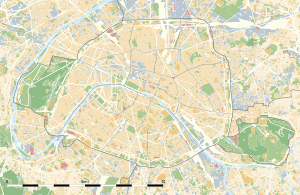Cimetière parisien de Bagneux
|
Entrance of the Cimetière parisien de Bagneux | |
 The location of the Cimetière parisien de Bagneux | |
| Details | |
|---|---|
| Established | 1886 |
| Location | Bagneux |
| Country | France |
| Coordinates | 48°48′22″N 2°18′32″E / 48.806°N 2.309°E |
| Type | Public (non-denominational) |
| Style | Rural |
| Owned by | Mairie de Paris |
| Size | 61.5 hectares (152 acres) |
| Number of graves | 83,000+ |
| Find a Grave | 1967750 |
Cimetière parisien de Bagneux is one of the three Parisien cemeteries extra muros, located in Bagneux. The cemetery has a large Jewish section (many of the divisions have exclusively Jewish graves) and is sometimes known as the Jewish cemetery.[1]
History
Before the site became a cemetery, it was the scene of heavy fighting in May 1871, in the war between the Versaillais and the Fédérés.
The cemetery was opened on November 15, 1886 and is one of the three Parisien Cemeteries extra muros, the others being Cimetière parisien de Thiais (openend in 1929) and Cimetière parisien de Pantin. It was opened at the same time as Pantin, (which is northeast of Paris). Both have similar entrances. Bagneux is the smallest of the three cemeteries serving Paris, but the most active.
Notes
The cemetery is still open and there about 10 burials a day. The cemetery is divided into 115 divisions. It is estimated that there around 83000 graves.
The cemetery was the burial place of Oscar Wilde until his remains were moved to Père Lachaise Cemetery[2] in Paris. Similarly, Jeanne Hébuterne, the model and artist who was Amedeo Modigliani's lover and mother of his only child, was originally buried here. Despondent over his death, Jeanne Hébuterne committed suicide and her family interred her at Cimetière de Bagneux until finally relenting and allowed her remains to be transferred to the Père Lachaise Cemetery in 1930 to rest beside Modigliani.[3]
There are nearly 5 500 trees (about 20 different species). It is home to many birds (35 different species have already been counted) and squirrels.
Notable burials
Monuments
There are monuments for:
- Jews who died in the Second World War (division 1)
- The Warsaw Ghetto (division 115)
- The victims of concentration camps and those who died as a result of "Nazi barbarism". There are many of these monuments in the Jewish divisions.
Military graves
The cemetery has a number of military sections.
There are two divisions dedicated to the French Military who died in the First and Second World War.
Division 19 contains two sections dedicated to Commonwealth dead and which are maintained by the Commonwealth War Graves Commission. These plots contain around 35 Commonwealth service war graves of World War I (mostly British soldiers who died in 1914), and a few from World War II.[4]
Individual burials
- Albert Rubin (1887–1956), French/Jewish Painter & Sculptor.
- Yury Annenkov (1889–1974), Russian & French artist known for his book illustrations and portraits.
- Junie Astor (1912–1967), singer
- Eugène Atget (1857-1927), photographer
- Barbara (Monique Serf) (1930–1997), singer
- Claude Berri (1934-2009), French actor, writer, producer, director and distributor
- Frida Boccara, (1940–1996), singer
- Lucienne Boyer (1903–1983), singer
- Martial Brigouleix (1903–1943), military hero
- Francis Carco (1886–1958), writer
- Marcel Dalio (1900–1983), actor
- Bella Darvi (1928–1971), French/Polish actress
- Léon Deubel (1879–1913), poet
- Jean-Jacques Gautier (1908–1986), author
- Michèle Girardon (1938–1975), French film actress
- Gribouille (Marie-France Gaîté) (1941–1968), singer
- Marcelle Henry (1895-1945), one of only six women who were awarded the Compagnon de la Libération
- Alfred Jarry (1873–1907), writer
- Jules Laforgue (1860–1887), poet
- André Leducq (1904–1980), cyclist
- Helene Rytmann (1908–1980), wife of Louis Althusser, resistance fighter during second world war and French communist activist
- Corinne Luchaire (1921-1950), actress
- Georges Madon (1892-1924), French WWI ace
- Jacqueline Maillan (1923–1992), actress
- Jacques Monod (1918–1985), actor
- Mela Muter (Maria Melania Mutermilch) (1876–1967), French/Polish artist
- Jean Paulhan (1884–1968), writer, critic
- Jehan Rictus (1867–1933), poet
- Jules Rimet (1875–1956), founder of the World Cup
- Alexander Salkind (1921–1997), film producer
- Stéphane Sirchis (1959–1999), musician, founder member of French band Indochine
- Jean Vigo (1905–1934), film director
Location
Located to the southwest of the city of Paris, France, the main entrance to the Cimetière de Bagneux is located at 43-45, Avenue Marx-Dormoy, in Bagneux, Hauts-de-Seine. There are two smaller entrances: Porte de Fontenay on Avenue Jean-Jaurès (near the junction with Avenue Marx-Dormoy) and Porte de Bagneux on Rue de l'Égalité (near the junction with Avenue de Garlande).
The cemetery is located next to the small local (communal) cemetery.
Public transport
![]() The Cimetière de Bagneux is a short walk from the Châtillon – Montrouge station, which can be reached by taking line 13.
The Cimetière de Bagneux is a short walk from the Châtillon – Montrouge station, which can be reached by taking line 13.
![]() The Cimetière de Bagneux is also served by bus lines 68, 128 and 323.
The Cimetière de Bagneux is also served by bus lines 68, 128 and 323.
There is a Vélib' station at Rue Molière (21209).
Gallery
-

The Jewish War Memorial
-

View of the central avenue
- ^ Although it is claimed that it is actually an Atlas Cedar
References
- ↑ (French) Burial of Claude Berri
- ↑ Oscar Wilde biography by the Oscar Wilde Society
- ↑ Jeanne Hébuterne on the Galerie Roussard website
- ↑ Cimetière de Bagneux on the CWGC website
| Wikimedia Commons has media related to Bagneux Cemetery. |
External sources
- Adapted (in part) from the article Cimetière de Bagneux, from Wikinfo, licensed under the GNU Free Documentation License.
